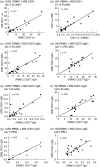Measurement of peripheral B cell subpopulations in common variable immunodeficiency (CVID) using a whole blood method
- PMID: 15932516
- PMCID: PMC1809387
- DOI: 10.1111/j.1365-2249.2005.02793.x
Measurement of peripheral B cell subpopulations in common variable immunodeficiency (CVID) using a whole blood method
Abstract
Recent reports have described reduced populations of CD27+ memory B cells and increased percentages of undifferentiated B cells in peripheral blood of patients with common variable immunodeficiency (CVID). This work has prompted two attempts to classify CVID based on rapid flow cytometric quantification of peripheral blood memory B cells and immature B cells. Evidence to support the hypothesis that such in vitro B cell classification systems correlate with clinical subtypes of CVID is being sought. For the classification to be useful in routine diagnosis, it is important that the flow cytometric method can be used without prior separation of peripheral blood mononuclear cells (PBMC). We have examined 23 CVID patients and 24 controls, using both PBMC and whole blood, and find an excellent correlation between these methods. The reproducibility of the method was excellent. We classified the CVID patients by all three of the existing classifications, including secretion of immunoglobulin by B cells in vitro as described by Bryant, as well as the more recent flow cytometric classification methods. Only one patient changed classification as a result of using whole blood.
Figures


References
-
- Ariga T, Okano M, Takahashi Y, Sakiyama Y, Matsumoto S. Analysis of B cell dysfunction in patients with common variable immunodeficiency by using recombinant interleukin 2. Tohoku J Exp Med. 1987;152:53–61. - PubMed
-
- Bryant A, Calver NC, Toubi E, Webster ADB, Farrant J. Classification of patients with common variable immunodeficiency by B cell secretion of IgM and IgG in response to IgM and interleukin 2. Clin Immunol Immunopathol. 1990;56:239–48. - PubMed
-
- Spickett GP, Farrant J, North ME, Zhang J-G, Morgan L, Webster ADB. Common Variable immunodeficiency: How many diseases? Immunol Today. 1997;18:325–32. - PubMed
Publication types
MeSH terms
Substances
LinkOut - more resources
Full Text Sources
Research Materials

